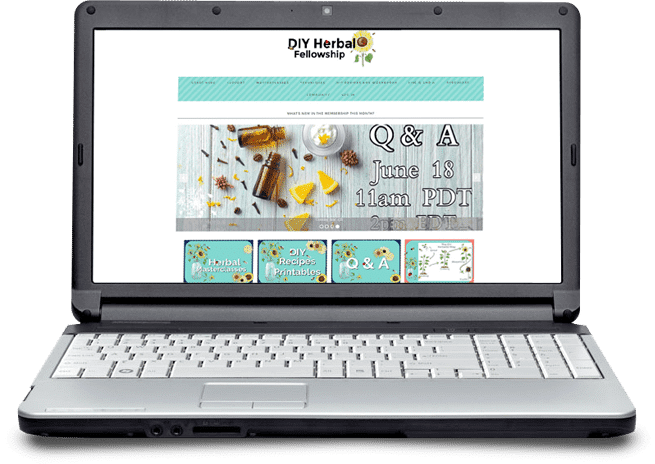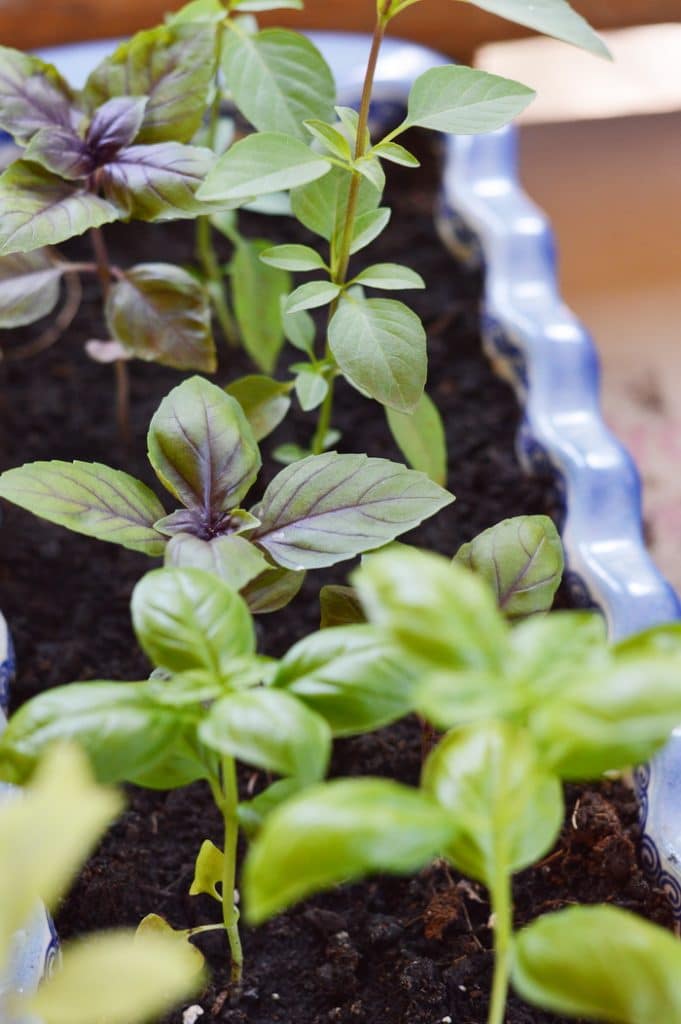Basil is one of our favorite Mediterranean and Indian herbs, with a sweet and somewhat spicy flavor that is unique and delicious. Learn how to grow basil at home, and enjoy an abundance of this herb, fresh, all year round. Even in cooler areas, you can grow basil indoors, outdoors, or in hydroponic garden.
This tender member of the mint family won’t invade your garden, like other mints. It can be grown in most temperate climates both indoors or outdoors. There are an abundance of basil varieties to choose from. Some are smaller and work well for small containers like purple ball basil, or spicy globe basil. Others like Genovese basil, lettuce leaf basil, and purple opal basil, will do better in large containers or being transplanted into the garden once they are large enough. There are also several more spicy basil varieties, including Thai basil, and holy basil which is also known as tulsi basil, as well as lemon basil and cinnamon basil types. Some say that the thai basil has a taste a bit more like anise or licorice than cinnamon though.

Ways to Start Your Own Basil Plant:
There are two main ways to grow basil, the first is from seed and the second is from cuttings. Seeds allow you to grow the huge variety of basil types and give you full control over the type of basil you want to grow the most. Cuttings are already mature and quicker to propagate and grow to a productive size. However, the basil varieties available for use as cuttings are going to be more limited than those available to grow from seed.
I like cuttings as you can take a quick cutting from an outdoor basil plant, when frost is threatening, and keep your basil going indoors, all winter. Or, you can take an existing basil sprig from a fresh-herb pack, and root that sometimes, either from the Farmer’s Market or your local grocery. The limitation is that there’s only two main commercial basil, Genovese basil, Red Genovese basil, and purple opal basil. A rooted cutting will grow happily in a sunny windowsill.

However, starting basil from seeds is awesome, as it gives more delicious basil-y options. There’s cardinal basil, a green basil with gorgeous purple bracts, that’s grown both as an herb and a flower. There’s mini basil varieties like green and purple ball basil, that are perfect for indoor growing, hydroponic growing, or aeroponic growing. There’s all the thai, cinnamon, lemon, and holy basil varieties. There’s even a giant lettuce leaf basil that has leaves large enough to use for wraps. So, seeds are awesome if you like having variety in the herbs you grow. Also, in warm climates basil can be a perennial, or a self-seeding annual, so starting from seed gives you more options for long term growing.
How to Grow Basil From Seed:
To grow basil from seed, you’ll need a few simple seed starting items.
- Basil seeds of your favorite variety
- Potting or seed starting mix
- A spray bottle
- Seed starting pots
- Tips and tricks for having your best garden ever
A note on seed starting pots, you can make your own using newspaper and a simple wooden tool, or re-use recyclable items like yogurt containers, just make drainage holes in the bottom. If using recyclable plastics, simply wash after up-potting, or transplanting to the garden, and put in the recycling as normal.

- If you’re working with a new bag of potting soil, or seed starting mix, it should already be slightly damp. You’ll still want to water it, before planting the seeds. If your bag is dried out, put soil into a large bucket, add water, and stir. Let it rest overnight to rehydrate before you use it.
- Once your soil is hydrated enough, fill your seed starting pots with soil. I like filling them to within 1/4 inch of the top, on small pots, and 1/2 inch on medium sized or larger pots.
- Gently press 1-3 seeds into the soil on the top of the pot, and cover lightly with damp soil.
- Sprinkle cinnamon on the top of the soil, if desired, to help stave off damping off disease. And place your pots in a shallow tray, this enables bottom watering if desired and protects surfaces from moisture.
- If you have a cover, put it over the seeds. If you don’t have a cover, spritz the surface of the soil where the seeds are 2-3 times a day to keep it damp enough for germination.
- To make the spritz: Fill your spray bottle with water, and add 1 tablespoon of hydrogen peroxide per two cup volume. This helps prevent damping off, and prevents mold or algae from forming on the surface of the seed starting, or potting soil, mix.
- Basil seeds germinate in 7-14 days, depending on temperature and moisture levels.
- Once your seeds have germinated, switch to bottom watering to encourage root development. If your seedling’s growth stalls, transplant or feed with a diluted liquid fertilizer, such as Alaskan fish fertilizer or kelp fertilizer. Most plants can be safely transplanted once they have 4 true leaves, the first 2 leaves are seed leaves, so wait till 6 total leaves have appeared after germination.

Encouraging Continued Growth of Basil Seedlings:
Once your plants are 4 inches high, pinch off the top few basil leaves and use them in your favorite recipe. This encourages bushing out, and makes for a more compact and productive plant.
Plant basil outdoors after your last frost date. About the same time you’d plant out tomatoes, eggplant, and peppers. Sweet basil does well in companion planting situations, with tomatoes, peppers and other vegetables, as well.
Basil likes direct sunlight, in most zones. But may need afternoon shade in super hot areas where plant growth stalls due to heat in late July and early August.
To encourage vibrant growth throughout the season, top dress the soil with compost, or fertilize with liquid fertilizer when you feed your other plants. Make sure to mulch well, to preserve soil moisture and inhibit weeds. Basil likes it a bit damper than, other Mediterranean herbs like rosemary or lavender.
Harvest basil by pinching off growing tips as needed, throughout the growing season, both to prolong production, and to have delicious fresh basil to use in pesto, pizza, sauces, salads, and other dishes. When the growing season is drawing to a close, cut a stem of basil and root it in water. There is no need to use rooting hormone with basil. This keeps the plant going indoors throughout the winter. When spring comes, you can always plant that cutting back outside, and let the plant flower in it’s second year, to feed the bees.
Troubleshooting your Growing Basil:
If you notice your basil wilting in the midday sun, but recovering in the evening, a shade cloth might be useful. Too intense sun will cause the plant to wilt to conserve moisture. Inter-planting basil with tomatoes can help reduce the amount of intense sun the plants get, as the tomatoes will shade them a bit when mature.
Basil’s strong scent can help confuse pests, for some crops. Try planting basil near crops that are attractive to flea beetles, Japanese beetles, or cabbage butterflies.
Slugs may find your young basil transplants attractive. Sprinkle diatomaceous earth around new transplants, or add slug traps near your garden beds. Hand picking is also effective at reducing slug population numbers.
I have not had aphids on basil, yet, they seem to prefer kale and other brassicas in my garden. However, if aphids appear, rinse them off with soapy water, or use this pest control spray. Most herbs are attractive to predatory insects, that prey on common garden pests. So adding lots of fragrant herbs like basil to your garden can inhibit pests that feed on your vegetables.

How to Use and Preserve your Basil:
Basil is delicious fresh. The taste of fresh basil is unique, spicy, with a mint-anise flavor that is unmatched. Different varieties have different flavor profiles so taste a few and find your favorites. Try them in watermelon basil salad or caprese salad of fresh basil leaves, tomatoes, and soft goat cheese.
Dried basil has a different flavor than fresh, with a more camphor flavor. Drying it gently with a low heat preserves more of the fresh basil flavor. Air-drying basil can cause the leaves to brown and the flavor to diminish. Use a dehydrator on low to preserve more of that minty-anise flavor. If you like having dry basil on hand, or dried tulsi or holy basil for teas, either bundle and hang in a shady area with good air flow, or dry in a dehydrator on 95F for 4 to 6 hours, or until crisp. Do not over dry. The flavor in basil is in the volatile oils that are fleeting in high heat.
Fresh basil may also be frozen. Chop basil using a chiffonade cut and place the finely sliced leaves in ice-cube trays with olive oil, lemon juice, or water. Freeze for 6-12 hours, or until solid. Remove cubes from the trays and place in labelled freezer bags. Use 2+ cubes in sauces, or other dishes to add that fresh, sweet, basil flavor. Or, if you’re using thai basil, that spicy licorice flavor. Basil may also be preserved in Pesto, and frozen in ice cube trays. (See this recipe for traditional basil pesto).
Basil is a great addition to any in-ground, or container vegetable garden. It is an amazing culinary herb, and the sheer variety of basil available can make every gardening year a new basil-related adventure.
Benefits of Basil:
Basil isn’t just a culinary herb. It has many uses in the herbal apothecary as well. Basil is one of the herbs that protects the brain. A nootropic, basil improves memory, encourages more brain connections, and nourishes brain cells, helping the brain heal and adapt. Basil also supports the body in adapting to stress, relieving some of the negative effects of stress on the body. Basil is also one of our radio-protective herbs, so its a great herb to use regularly if you have a job that exposes you to low-dose radiation, or if you have a lot of SMART appliances in your home. While Tulsi basil is normally the basil cited for medicinal use, both sweet basil and holy basil share the same medicinal actions and benefits. Basil is also a strong antioxidant, antimicrobial, and antiviral herb. Basil family plants can help with immune support, and aid with memory. They can be uplifting, and help against depression and anxiety.

These are just some of the benefits of basil, and there are many more actions and health benefits that basil offers. Learn more about Basil, and many other herbs, at The DIY Herbal Fellowship, our exclusive herbal membership, where you can get an herbal education tailored to your unique needs. For a small monthly fee you receive a new masterclass each month, and access to all past classes as soon as you sign up. These classes emphasize growing herbs and using them for wellness, while developing a unique regional apothecary.
Last month we learned about basil and tulsi basil in depth, as well as other radio-protective herbs (herbs that protect from radiation of all types).





I have had only a chance to skim this article but I’m totally fascinated with your tips about cinnamon and water/peroxide spray for the top of seedling pots. I’m looking forward when I get to come back and really read this. 🙂